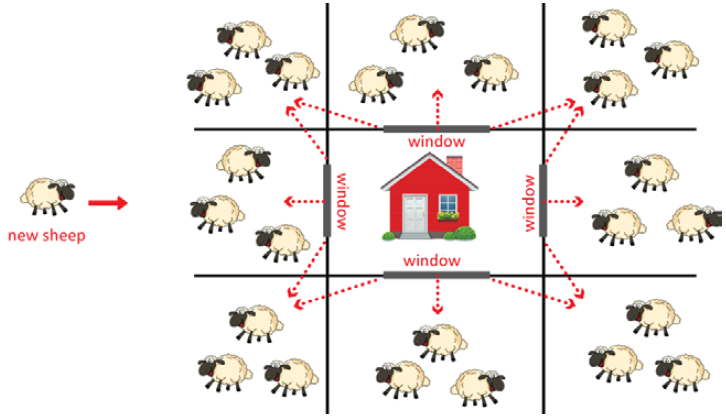The farmer's sheep II
This problem solving activity has an algebra focus.
A farmer can see nine sheep if he looks out of any of his four windows.
His wife gives him a new sheep.
Which paddocks can he put the new sheep in so that he can still see nine sheep from each of the four windows?
What is the largest number of sheep that his wife can give him so that he can still see 9 sheep through each window?
What is the smallest number of sheep that his wife can give him so that he can still see 9 sheep through each window?
If there is to be at least one sheep in each paddock, what numbers can the farmer have and still see 9 sheep through each window?
- Describe a number pattern in words.
- Devise and use problem solving strategies to explore situations mathematically.
This problem helps to develop students' problem solving skills, logical thinking and their ability to work sequentially. It also helps develop rules for mathematical problems, although these rules may not be obvious at first.
Students are also challenged to maximise and minimise the problem, by having to find the largest and smallest number (of sheep) that satisfy certain conditions. This is a common theme of mathematics, motivated by the real world and its demands.
This problem builds upon Farmer’s Sheep I, Level 3.
- Counters or plastic animals
- Large grid (to use when displaying the problem)
- Copymaster of the problem (English)
- Copymaster of the problem (Māori)
The Problem
A farmer can see nine sheep if he looks out of any of his four windows. His wife gives him a new sheep. Which paddocks can he put the new sheep in so that he can still see nine sheep from each of the four windows?
What is the largest number of sheep that his wife can give him so that he can still see 9 sheep through each window?
What is the smallest number of sheep that his wife can give him so that he can still see 9 sheep through each window?
If there is to be at least one sheep in each paddock, what numbers can the farmer have and still see 9 sheep through each window?
Teaching Sequence
- Pose the problem.
- Put a large version of the grid up in the classroom and point out the features e.g. where the windows are.
- Explain the rules:
The new sheep must go in a paddock, it cannot be destroyed, hidden, eaten, etc.
The farmer must be able to see a total of nine sheep from the three paddocks he can see from each window. - Encourage the students to work in pairs and record the problem solving sequences they go through.
- As students work, ask questions to encourage them to explain and justify their thinking:
Can you see a pattern?
How can you describe what is happening?
How are you working systematically?
How are you recording your thinking?
What else could you try?
What do you still need to do to solve the problem?
How do you know that your solution is correct? Could there be another solution? - Share solutions. Is there a rule?
Solution

The simplest answer is shown above. However, there are 16 answers in all. These are given in the Level 1 Algebra problem Farmer’s Sheep I.
To maximise the number of sheep, you want to put the smallest numbers in the corners. There are two reasons for this. The first one builds on the solution to Farmer’s Sheep I, Level 3 but it is not the easiest way. It has the smallest number of sheep go in the corner because the number of sheep + the numbers in the corner paddocks = 36
As the number of sheep goes up, the number in the corner paddocks goes down to keep the sum constant at 36.
Because you have to have at least one sheep in each paddock, you need to put one sheep in each of the corner paddocks. This gives the answer below as the only possibility. There are 32 sheep.
| 1 | 7 | 1 |
| 7 | 7 | |
| 1 | 7 | 1 |
But it is simpler to look at it in the following way. This way it may be easier to convince the class. Suppose that we put any number in a corner. Reduce this number by one. In order to keep the two ‘window’ sums that include that corner equal to 9, we’ll need to add one to each of the paddocks on either side of this corner. This will change the sheep count by –1 + 1 + 1 = +1. So reducing the number of sheep in the corner paddock increases the total number of sheep by one. This means that we want to put the smallest number of sheep in each corner paddock. This smallest number is 1.
Similarly to minimise the number of sheep you want to put the biggest possible numbers in the corners. (You use the same argument that we used above on the corner paddock. But this time increasing the number of sheep in this paddock will reduce the total number of sheep.) This gives you 20 sheep.
| 4 | 1 | 4 |
| 1 | 1 | |
| 4 | 1 | 4 |
Having got this far you can get any number of sheep from 20 to 32. Start from 20. Then systematically move one sheep from a corner paddock to a neighbouring centre paddock; now add another sheep to the window side that has been reduced by one. This rule should get you from 20 up to 32 sheep.
